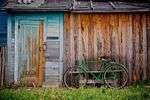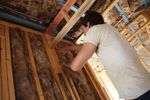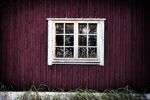If you’re thinking about joining the tiny house movement, there are a lot of things to consider. Do you want to buy or build? Do you want a tiny house built on a trailer, or out of a shipping container, or any other way?
There’s a lot of planning that goes into the process. But what many people don’t realize is how easy it is to build a simple tiny house out of structures you already own. In particular, a shed you may have in your backyard.
Since the beginning of the tiny house movement, people have been thinking about the practicality of how to turn a shed into a tiny house. And it’s not only a practical option, but it’s cheaper, easier, and faster than doing it from scratch.
If you’ve got a barely used shed lying around this could be the beginning of a beautiful thing. You can even buy one for the purpose. Here are the ins and outs of how to turn a shed into a tiny house!
Why Turn Your Shed Into A Tiny House?

But first, let’s cover all of the reasons why people choose to take this route to tiny house building. That way, you can take this information and decide if it’s the right choice for you.
It’s Cheaper (Sometimes)
Aaah, the answer that everyone wants to hear. Yes, converting your shed into a tiny house is cheaper than building almost any tiny house. This mainly depends on whether or not you have a shed at hand, or how much it will cost you to buy a new one.
If you already have an unused shed that you want to convert, that’s perfect! Overall costs will be minimal compared to a complete build. If you have to buy a new shed, a simple model should set you back much less than a tiny house shell will.
Shed manufacturing is a super streamlined process involving materials at wholesale prices. A basic shed is about as cheap a building structure as you can buy. Either way, as long as you’re not set on being fancy, your tiny house shed is going to save you more than just pocket change.
It’s Faster To Build
While it can be tempting to build your house entirely from scratch, it isn’t the most time-effective method. One of the most popular ways to build a tiny house is to buy a shell – a prebuilt structure consisting of foundations, walls, and a roof. The interior can then be designed and filled in whatever way your heart desires.
Using a shed as a shell of sorts means you’ll be able to finish your build and move into the tiny house much quicker than a from-scratch build. Of course, this does not apply if you’re planning to have your tiny house custom-built.
A Higher Quality Tiny Home
Yes, you read that right. Tiny houses are a relatively new concept (at least for the mainstream population). As a result, the industries that are springing up around this movement are still ironing out the kinks in their production. A tiny house shell you might build may be of a lower quality than the shed you could use.
Sheds have been designed and perfected in their respective industry for decades. A well-built shed is constructed by experts. This also applies to building a tiny house from scratch – unless you are an experienced builder, a shed is likely to be better built than your own construction.
Potential Issues
But there are also downsides to this kind of build. And when you are thinking of how to turn a shed into a tiny house, these points may make you reconsider.
First, while building from a shed is a fast and cheap way to construct your own tiny house, it doesn’t leave much freedom for customization. Unlike a normal tiny house where you can choose from a range of types, or even build from scratch yourself, this build is going to be restricted to the kind of shed you have.
Your interior design and layout are going to depend entirely on the shape of your shed. And while sheds do come in varying shapes and sizes, they are still more limited than a traditional tiny house build. If you have a more unique floor plan in mind, you may want to think twice about a shed conversion.
There is also no opportunity for transportation when you are building with a shed. Part of the reason many people choose tiny living is the option to have a tiny house on wheels. This way, they can easily pick up their home and move it wherever they need. They can even travel as tourists from their own homes.
Unfortunately, sheds aren’t constructed for the road. If you are looking into converting your shed, you’ll have to be content with being stationary.
What To Consider

There are a few other things you need to consider before diving into a shed-to-tiny conversion. These points are important, as they ensure a safe, durable, and long-lasting tiny house conversion. Without covering your bases, you could be pouring a lot of time and money into a build that fails miserably.
First, look for a shed with 2×4 or 2×6 lumber framing. These are the strongest construction options for a shed, as they will be able to hold up the walls and ceiling of your home. It will ensure that your structure can stand the test of time.
2×3’s won’t cut it, and you avoid converting a shed with 2×3 framing construction. These structures are incredibly difficult to insulate properly, and will not hold up the walls and ceilings of your home.
Metal roofs are a must. Metal will save you a lot of money on heating and cooling options for your home. They are also more weather-resistant, protecting your home from rain, high winds. They don’t corrode or take on mold, and in general, last far longer than traditional roofing.
Your foundations are also important. A shed-converted-tiny house is only as good as the foundation it’s placed on, after all. An uneven surface, or one that cannot withstand the elements, will drastically reduce the lifespan of your home. You should always avoid dirt and sod. A concrete pad or cement block will always be better alternatives, lifting your shed out of reach of soil.
Converting Your Shed Into A Tiny House
Now it’s time to learn how to turn a shed into a tiny house. We’re going to cover this in 10 unique steps. Follow them closely, or customize them along the way. Either way, if you follow this checklist you’ll have your own DIY tiny house converted in a matter of weeks or months.
1. Seal Up Any Cracks
Because most storage and garden sheds are only built with the purpose of storage, they don’t enter your life in the best condition for living. So the first thing you need to do to make a shed liveable, by sealing up any gaps in the structure. Once you’ve caulked the joints, seams, and gaps in your shed, you’re one step closer to protecting your tiny house from the elements.
2. Insulation
Insulation is one of the most important parts of building any structure. Without sufficient insulation, your tiny home will be virtually unlivable. It provides warmth in cold weather, keeps your living spaces cooler and more comfortable in hot weather, and is an excellent way to soundproof if you’re in a residential area.
Don’t forget to add weatherstripping to your doors and windows! This will seal off any potential gaps in these spaces and further protect them from rain. It will also save you money in the long run. Weatherstripping keeps the interior air-sealed in, lessening the need for heat and air-conditioning.
3. Interior Walls

This can be drywall, shiplap siding, or metal. Either way, you need some interior walls to make your shed feel like a real tiny home. Though simple drywall is a cheaper option, leaving bare drywall can make your interior more susceptible to moisture, leading to eventual mold and rot.
We recommend shiplap siding, as it is cleaner and easier to install. Not to mention, if you’ve got a handy table saw at home you can make your own siding quickly and easily. Shiplap siding and metal are also good options because their cabin-esque styles match the aesthetic of a converted shed perfectly.
4. Utilize The Storage
Many sheds often come with pre-built storage, used for any equipment that might need to be stored separately. While it can be tempting to tear everything out and start from scratch, we strongly recommend you leave any hooks, shelves, or closet spaces intact.
These spaces are incredibly useful. They can be easily refurbished to store or display any of your belongings. In a tiny house, storage is sparse, so you need to take any opportunities you can to maximize storage space.
5. Install Heating Or Air Conditioning
This is something you will have to assess as per the needs of your home. If you live in a moderate two-season climate, insulation may be enough to keep you comfortable in any weather.
But if you live in a harsher climate, you will likely need to install a heating or air condition system to keep a balanced temperature in your home. But it doesn’t have to be too complicated. If you’re building on a low budget, this could be as simple as a small heater or a few standing fans.
6. Power Your Tiny House
If you plan to live in your tiny house shed, you need to find a way to power it. The most common way to connect electricity to a tiny house is through solar power. While connecting up to a nearby grid may seem like the intuitive option, it isn’t popular for tiny house owners.
That’s because solar is cheaper, faster, and more accessible. And these days there are many options on offer, so you can pick the kind of system that best suits your needs.
7. Install Windows
It’s hard to truly enjoy a living space if there are no windows. To let that beautiful light into your new tiny home, you want to make sure you have a window or two. In fact, for maximum light (which will make the room feel more spacious), you should add a window on at least two walls.
8. Lighting Installation
Good lighting is a must for any home! You should be looking for both overhead lighting and lamps for the corners of the room. You should also consider adding an outdoor light as well, for people coming and going in the evenings. It will also be helpful if you plan to spend time outdoors during the summer. Shed lighting is often stark and white, but for living spaces, you should opt for warmer light bulbs.
9. Decide On Plumbing
Now you need to decide if you want plumbing as an option in your home. This usually comes down to having a toilet and a shower. If your tiny house is going to be used on a section of land with a larger house, it may not be necessary.
But if it is far from other accessible bathrooms, it’s time to think about installing proper plumbing or look at buying a composting toilet.
10. Finish Your Flooring
The last piece of the puzzle before you start moving your furniture in. Most tiny houses have carpet, tile, or cork flooring, but you should go for whatever is most comfortable. You should also think about durability – you may want to forego the effort of installing new flooring, but the old wooden flooring may be susceptible to mold.
Final Thoughts
As you can see, learning how to turn a shed into a tiny house is not devoid of pitfalls. But it is a fantastic way to get the tiny house you’ve always wanted with less fuss, time, and cost than you can expect in a normal build. Now it’s up to you to make it happen!


